Image
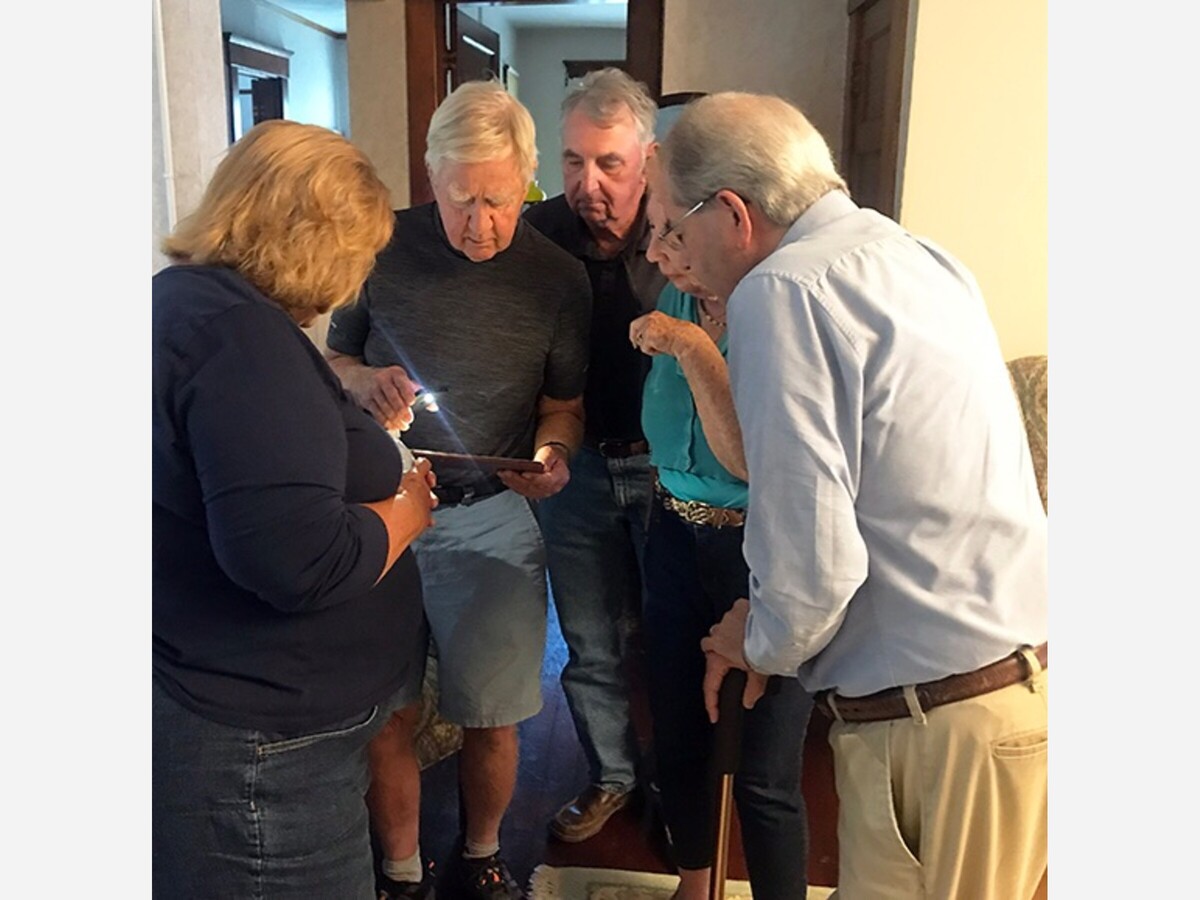

NEW BURLINGTON, OH -- While many enjoy the recreational fun of boating, swimming, skiing, camping, hiking or even just picnicing at Caesar Creek, often forgotten is how the making of this 2,830-acre man made lake and state park removed approximately 300 people from a place they called home.
Just northeast of Waynesville, Ohio a sign still stands with the razed town’s name…. New Burlington.
Prior to the state park officially opening in 1978, New Burlngton was a thriving little town with a post office, a school, a barber shop, a grocery store, a gas station, a hardware store, a methodist church, a masonic lodge, homes and farms.
While New Burlington village boundaries encompassed protions of both Spring Valley Township in Greene County and Chester Township in Clinton County, the dam that was to be built to make the lake was being built just south of New Burlington in Warren County.
“The Army Corp of Engineers prior to 1970 thought they needed to control some type of flooding that really was happening on the Little Mimia River in southern Warren County around Morrow,” explained Roger Vaughan, who was at Waynesville’s Museum at the Friends Home sharing his memories of the village that is no more.
Vaughn explained that the thought was …. “If they could control northern Caesar Creek and Anderson Fork that come together at New Burlington, they could have a dam that could keep the flooding minimal down in Morrow and little bit south of Morrow.”
While Vaughan was not from New Burlington, his wife was. “I believe I was the last one to get married in New Burlington at the old Methodist Church,” he said explaining his connection to the town.
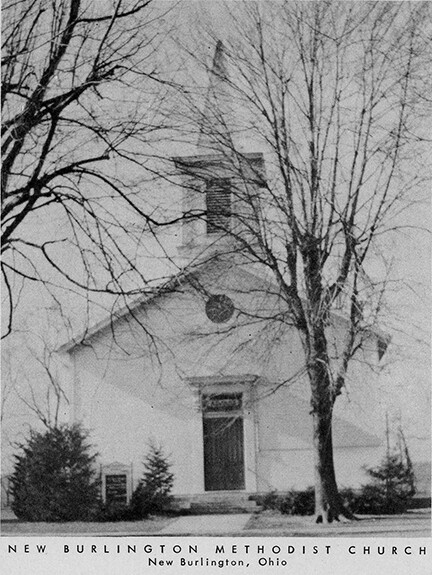 (Photo Courtesy of Waynesville's Museum At the Friends Home) Picture of the New Burlington Methodist Church.
(Photo Courtesy of Waynesville's Museum At the Friends Home) Picture of the New Burlington Methodist Church.Most of the towns people who were forced to move have passed. It’s been close to 50 years since the park officially opened in 1978, and in April of this year, it will be 50 years since the last villager left.
It was Lawrence Mitchner, 87, who was the last to leave the village on April 20, 1973. According to author John Baskin, who in 1972 spent one year living in an abandoned house in the village so he could write the villagers’ stories, Lawrence died at the place he called home.
“In the spring of 1973, all of New Burlington is gone except four buildings: the old cobbler’s shop, the Quaker church and two houses,” wrote Baskin in his book New Burlington: The Life And Death Of An American Village.
In his book, Baskin describes the 87-year-old man’s home…
"Now the house sits in the middle of the empty bulldozed lots which fill with weeds and vines. The country highway in front, Route 380, is noisier to him now as the cars come down into the heart of what was once a village and turn sharply across one of the two streams. He knows that the other buildings helped absorb the noise.
He seldom answers the door now. He refuses to see Corps appraisers and when they write him he takes the letters and tears them across and hands them back to the postman."
According to Baskin, Lawerence’s death certificate read he died of a heart attack.
Jim Prickett, volunteer at Waynesville’s Museum at the Friends Home, invited some of the New Burlington residents who were still around to come tell their story and share their memories of the village that is no longer. Paula Dytko of Aulalou Photography was there to capture their memories through video.
“I did not know until this spring the lake was actually suppose to go farther north up Route 380 to Spring Valley Paintersville Road, but for some reason that part of the lake got discontinued," Vaughan noted.
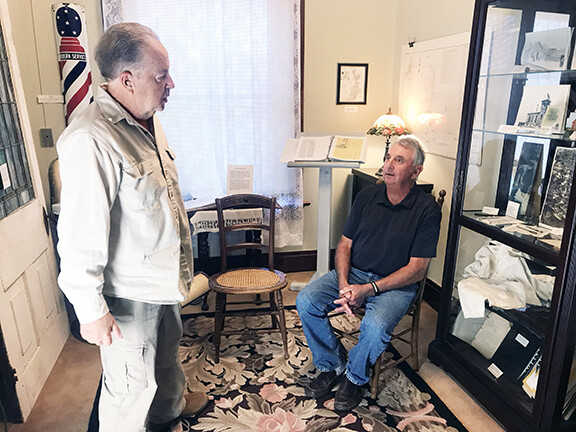 Jim Prickett (standing) gets ready to interview Roger Vaughan.
Jim Prickett (standing) gets ready to interview Roger Vaughan.Prickett added, “They came in with a lot of money, and they seemed to have bought an awful lot of ground... more than for the lake itself. A lot of farmers, I know, lost ground that would never be underwater, but at the same time, I think the State had this idea that we would use it in the future for recreation purposes.”
Vaughan explained that most of the people he knew did not move far … just a few miles up the road and that many of the houses were built so well the houses actually moved with their owners up the road.
Charles MacIntire, who grew up on a farm just a mile and a half up the road from the village, came to share some of his memories.
'The hardware store was the source for everything. If they didn’t have it, you didn’t need it,” he said.
While he was not one who had to move from his home, he explained how it effected his grandmother who had sold the farm after her husband died. She had moved into a house in the village.
“She had to move. She moved in with her sister, then, she moved in with my parents,” McIntire said explaining she felt displaced.
"She died a sad little old lady,” he said.
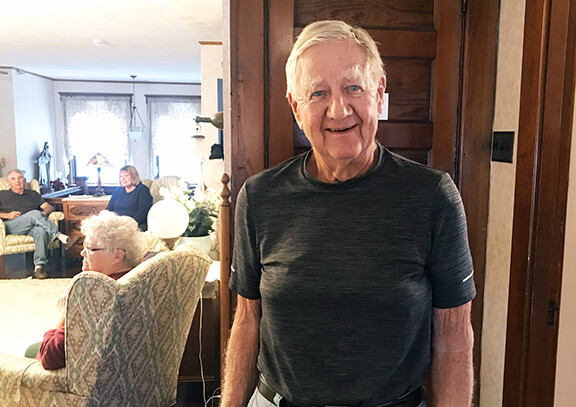 Charles McIntire shared his thoughts of New Burlington
Charles McIntire shared his thoughts of New BurlingtonAt first McIntire said he was going to never step foot in the lake, but over time he did change his feelings, and he added he has been on it and has learned to accept it.
"The Methodist parsonage was in both Clinton and Greene Counties," added Rosalie and John Beers who also shared how the New Burlington Methodist Church brought them together.
"The county line went right down the middle,” John said.
John was assigned to be the pastor of the New Burlington Methodist Church in 1959. According to Rosalie, it was their fathers, who were both Masons, that hit it off and became friends. Over time Rosalie and John began to date, but not until Rosalie moved to an apartment in Dayton. Then in February on the tenth in 1962, the two were married at the New Burlington Methodist Church.
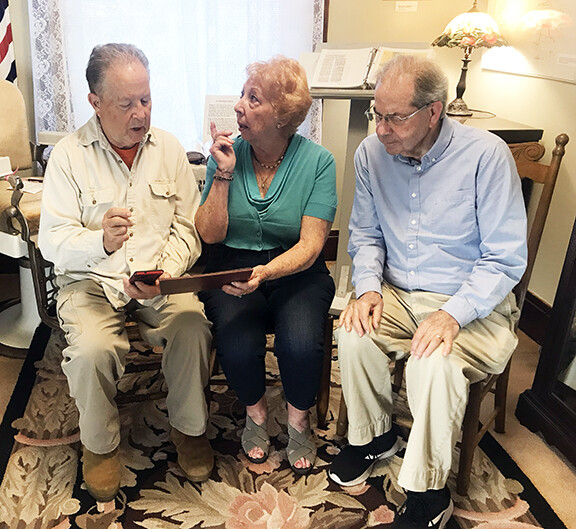 Rosalie shares information about the old church's stain glass windows with Jim and John.
Rosalie shares information about the old church's stain glass windows with Jim and John.Rosalie shared another fact about the town that is no more… the old school house had been bought by the Masons and had been turned into a masonic lodge.
Cheryl “Peach” Lovett Hawkins' story was somewhat different than the others, for she was only 12 when her family had to move from their home.
"It seems like there was talk of this a few years before it became a reality. I remember going to meetings when I was small and laying my head over on parents lap," Hawkins said.
"People of the town begged, just basically begged for them not to take their town...It was our home," she added.
Hawkins held back tears as she explained, "it was very sad. The farm we lived in... my mom was born there. It was ours... and it was being taken away from us."
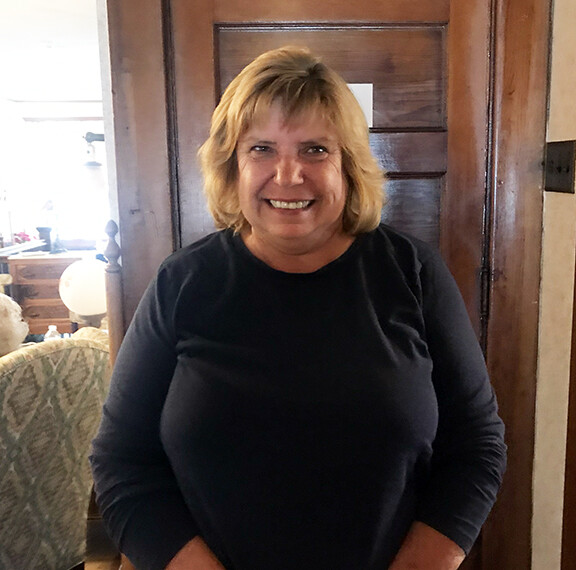 Cheryl "Peach" Lovett Hawkins was only 12 when her family had to move.
Cheryl "Peach" Lovett Hawkins was only 12 when her family had to move."I remember when they would come to meet with my parents about buying it, and they would give them an offer. My mom and dad would say this is absurd. This is what a willing buyer would give a willing seller and my dad would say we are not willing. I don’t want to sell, but they had no choice."
Hawkins explained that they moved a couple miles up the road and built a ranch home and barn. "It wasn't home. It wasn't the big old farm house we knew and loved... Honestly, it breaks my heart more now then at the time."
"My parents till the day they died would tear up," Hawkins added.
“It's been said that Ceasars Creek is built on a lake of tears,” Prickett ended.
To learn more about New Burlington visit Waynesville's Museum At the Friends Home located at: 115 S. 4th Street, P.O. Box 12, Waynesville, Ohio 45068 or call 513-897-1607. All the photos in the photo gallery our courtesy of Waynesville's Museum At the Friends Home.